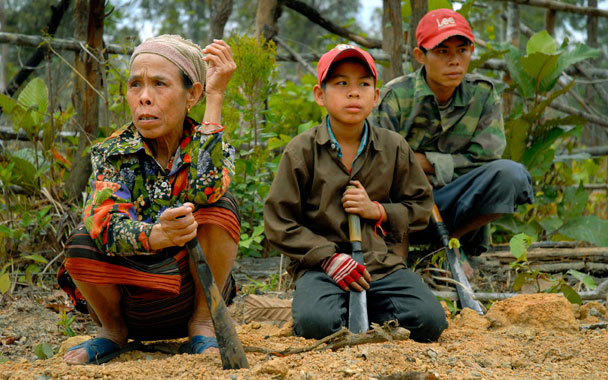Joy, a 36-year-old villager, works her way through a muddy Laotian forest of thorny rattans, machete in hand. “I was looking for food—bamboo shoots and vegetables—when I found the rocket,” she says. “I didn’t touch anything. I just marked the spot on a tree. This was the first time I saw unexploded ordnance (UXO) in the forest.”
The first time for Joy, but not for thousands of other farmers across Laos, where the land remains littered with explosives from the US bombing campaign between 1964 and 1973. In that time, the United States dropped 2 million tons of explosives over Laos in an effort to eradicate Communism and destroy the Ho Chi Minh Trail. Up to 30 percent of those bombs never detonated, for various reasons, and the Laotian soil remains contaminated today. There are no accurate death tolls, but villagers are killed and injured by ordnance every week. “Digging is dangerous,” says Jim Harris, a retired school principal from Wisconsin who spends part of the year in Laos working with the New Zealand–based Phoenix Clearance Limited, an ordnance removal company. While the entire world contends with rising food costs, Laotian farmers face the ultimate price: the danger of losing life or limb.
Joy leads a PCL team on a hunt for the rocket. “It was long like this,” she says, stretching her arms three feet wide. But when we reach the spot, it's gone. The ground is covered in buffalo tracks, and Harris suspects other farmers moved the rocket to protect their animals. “Now we have to figure out where they put it,” he says.
But the team never does.
The next morning, the PCL group heads to a patch of wooded land that farmers are clearing for sticky-rice cultivation. They have found a “bomblet,” one of the most common types of ordnance, dropped from large cluster bombs that spray hundreds of submunitions across the ground. (These weapons have gained attention recently as 111 countries signed a treaty to ban cluster bombs; the United States was not one of them.)
Three children and two adults emerge from the forest. “We’re afraid,” says a young man named Pha. “We come here often. Our garden is here.”
The PCL team prepares to blow the bomb, packing the explosive with TNT and running a firing line to a detonator hundreds of meters away. Megaphones boom through the forest, instructing people to clear out. Villagers huddle in safety near the firing point behind a PCL truck. They cover their ears as a spectacular thunder rattles the forest, ending in a poof of smoke. When all is clear, we head to the site, retrieving pieces of the shattered bomb and its tiny ball bearings, which gleam like black pearls and reek of burning metal. Pha and his family smile in relief.
I see that smile again tenfold, a few days later, on the face of a 15-year-old beanpole of a kid named Chit. Through puffs of cigarette smoke, this cool-talking teen leads the PCL team to a bomblet in a remote farm field. I watch Chit crouch behind a tree, peeking from behind, his face alight with wonder and awe as the bomb explodes. “I tell deminers about UXO so many times, but I’ve never seen their disposal before,” he beams with pride.
It’s Friday afternoon—one more bomb removed, one more field safe for growing. And countless lives saved.


